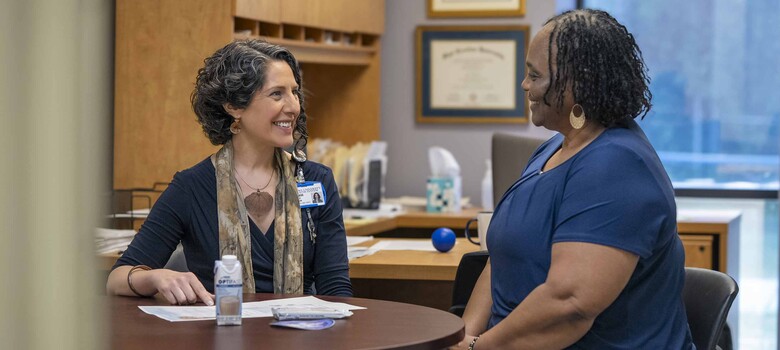 From the DukeHealth.org archives. Content may be out of date.
From the DukeHealth.org archives. Content may be out of date.
Growing Pains

Sore muscles and creaky joints are part of the package deal of growing old, but musculoskeletal pain isn’t limited to seniors. As any pediatrician can tell you, it’s common in the tricycle set too. Laura Schanberg, MD, a pediatric rheumatologist, explains the origins of chronic pain -- and what parents can do to help their kids feel better.
Musculoskeletal pain (pain of the bones, joints, and muscles) is one of the most common childhood complaints. Surprised? You are not alone. In fact, it has only been over the last 10 to 20 years that pediatricians have recognized pain as a normal part of the developmental experience. As recently as the 1980s, pediatric doctors-in-training were taught that pain complaints in a child indicated the presence of disease because healthy children did not have pain. Fortunately, advances in our ability to assess pain in children have revealed that children routinely have pain without the presence of an underlying illness or injury.
Musculoskeletal Pain in Healthy Children
So how common is musculoskeletal pain in children? Well, researchers have estimated that anywhere from 5 to 30 percent of children have chronic pain complaints. The vast majority are benign, with symptoms attributable to trauma (30 percent), overuse (28 percent), normal skeletal growth variation (18 percent), and growing pains (8 percent). Regardless of cause, benign childhood pains can persist for several months or even years, and are more common in girls and older children. In fact, studies have shown that about half of all girls complain of some type of musculoskeletal pain during their teenage years!
Of course, pain can be a symptom of many underlying diseases, including inflammatory diseases of the muscles and joints, endocrine abnormalities, and malignancies. In addition, sometimes physiologic pain responses can become exaggerated due to changes in the pain processing system -- resulting in a pain syndrome such as growing pains, fibromyalgia, lower back pain, and chronic sports-related pain syndromes such as Osgood Schlatter’s and patellofemoral syndrome.
Since so many healthy children have pain, how can we know when pain is a sign of a larger problem requiring special care? In general, children with systemic illness that is causing musculoskeletal pain have additional symptoms and abnormal physical examination findings. Children with chronic illness often fail to thrive -- they may lose weight or fall off their growth chart in height and weight. They may experience fever and fatigue. They are more likely to limp or show decreased ability to move their joints. Children with cancer as the cause of bone pain are more likely to have severe pain in the middle of the night that causes them to waken.
Routine lab testing may identify a disease as the culprit for pain, but the key is often the physical exam. In fact, there are no laboratory tests to make a diagnosis of juvenile arthritis. Instead, diagnosis is based entirely on findings present on a thorough physical examination. To understand this process better, it is important to understand the distinction between arthritis (joint inflammation) and arthralgia (joint pain).
What is Juvenile Arthritis?
The word arthritis literally means joint inflammation (arth = joint; itis = inflammation). Joint inflammation causes joint pain, stiffness, swelling, and decreased mobility. Not all joint pain is arthritis; arthralgia (arth = joint, algia = pain), joint pain without signs of inflammation, is actually more common than true arthritis. Arthritis can be a self-limited illness when caused by a viral or bacterial infection or a chronic rheumatic disease, meaning that it may last for months or years and then subside. Juvenile arthritis refers to inflammatory arthritis or an arthritis-related condition (a.k.a. rheumatic disease) that occurs before age 16.
About 285,000 children in the United States have a form of juvenile arthritis. The most common form of chronic arthritis in children is juvenile rheumatoid arthritis (JRA). Estimates vary on the number of children in the United States who have JRA; however, it is one of the most common chronic childhood illnesses, occurring nearly as often as insulin-dependent juvenile diabetes. Arthritis can also result from many other diseases, including diseases that affect the spine (ankylosing spondylitis), skin (psoriasis), gastrointestinal tract (ulcerative colitis and Crohn’s disease), and other organs (systemic lupus erythematosus and vasculitis). Arthralgia may also occur in these disorders as well as in non-inflammatory pain disorders such as fibromyalgia, a generalized pain disorder, and localized pain disorders such as complex regional pain syndrome, growing pains, and sports-related pain disorders.
Diagnosing Juvenile Arthritis
How can you find out if your child’s musculoskeletal pain is arthritis? Symptoms of JRA include fatigue, joint swelling, stiffness, or pain, which is often worse following sleep or inactivity. However, because JRA affects each child differently, your child may not experience all of these symptoms. Your child’s doctor may take many steps to find out if your child has a form of juvenile arthritis:
- A complete health history to establish the duration and character of symptoms, rule out other possible causes such as trauma or viral infections, and find out if other family members have had arthritis or related conditions.
- A complete physical examination to look for joint inflammation, rash, nodules, and eye problems that may suggest the presence of juvenile arthritis or related conditions.
- Laboratory tests to determine the erythrocyte sedimentation rate (sed rate or ESR), antinuclear antibody test (ANA), rheumatoid factor test (RF), HLA-B27 typing, complete blood count, and urinalysis. Other tests may be ordered as determined by your doctor.
- X-rays of joints to check for signs of joint damage.
While a complete medical assessment as outlined above is recommended for children with unexplained and persistent joint pain, the diagnosis of JRA is based on the findings of physical examination -- that is, the presence of joint inflammation (warmth, swelling, pain with motion, and decreased range of motion) upon physical exam in the same joint for at least six consecutive weeks. There is no laboratory test to diagnose the juvenile arthritis; however, lab testing may assist in classification of arthritis or determining risk of more severe disease.
Your child’s doctor may refer him or her to a pediatric rheumatologist, a physician who specializes in treating children with arthritis, to help make the diagnosis or for treatment. Duke has pediatric rheumatologists who can help your doctor diagnose benign childhood musculoskeletal pain or juvenile arthritis.


